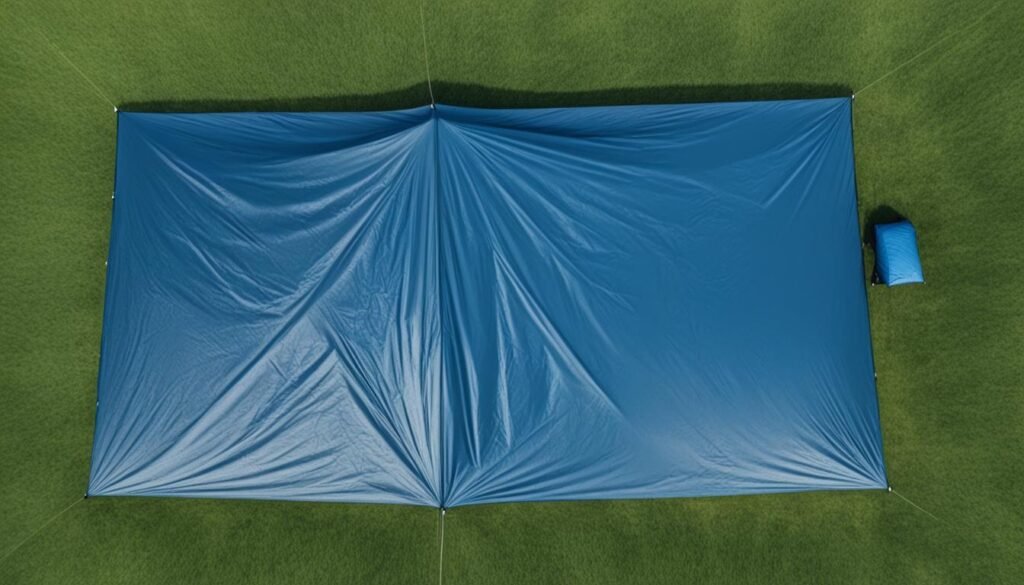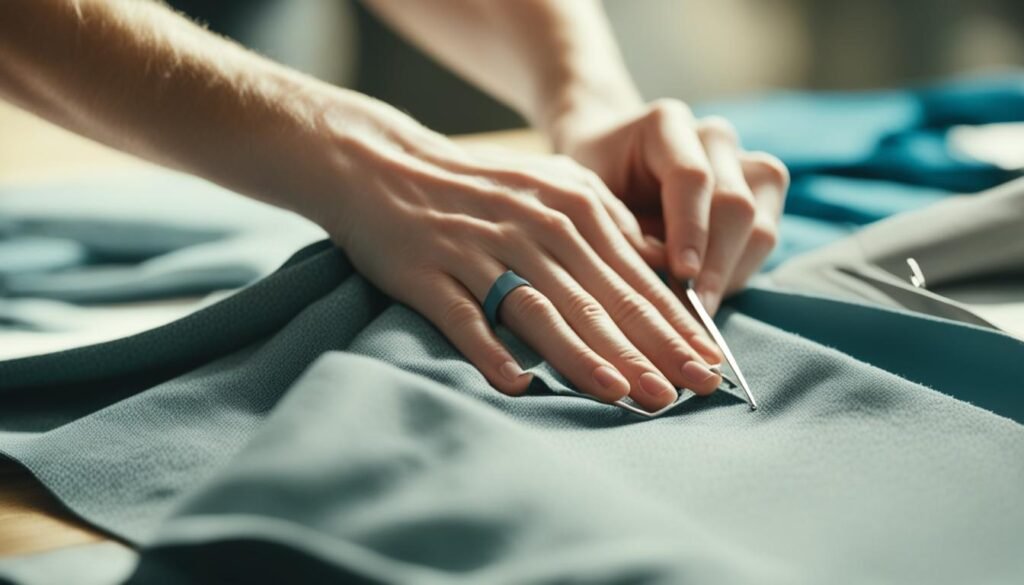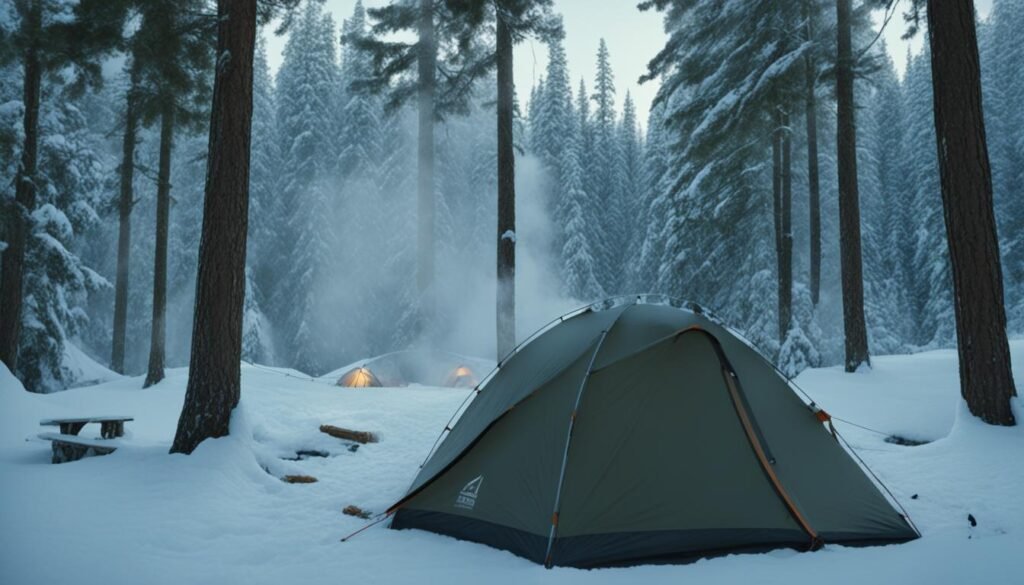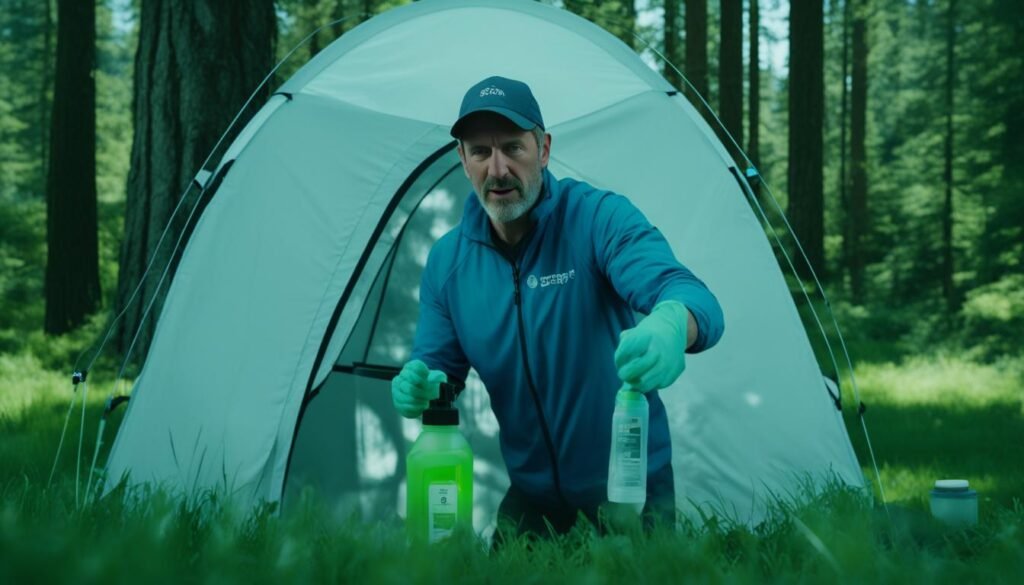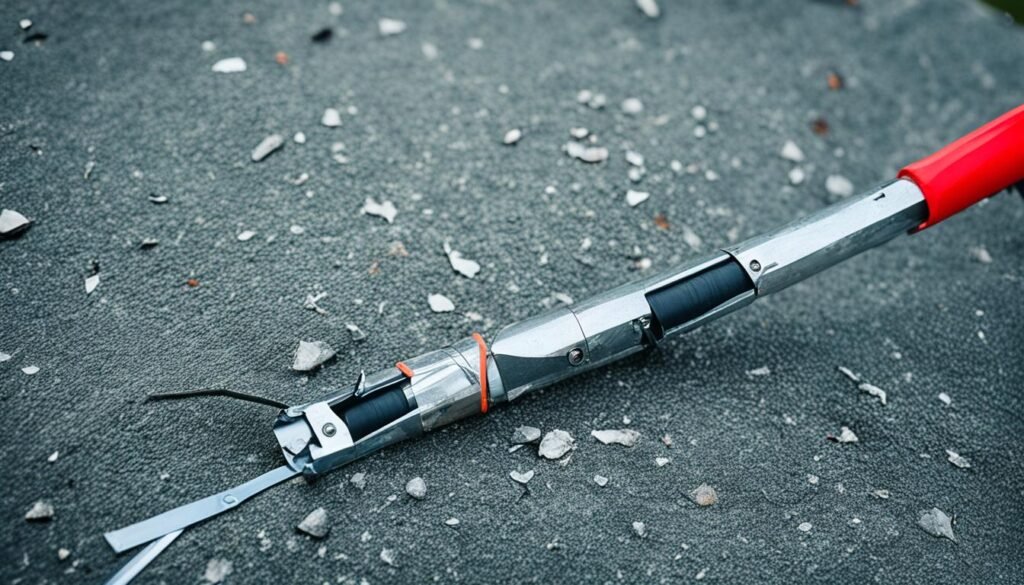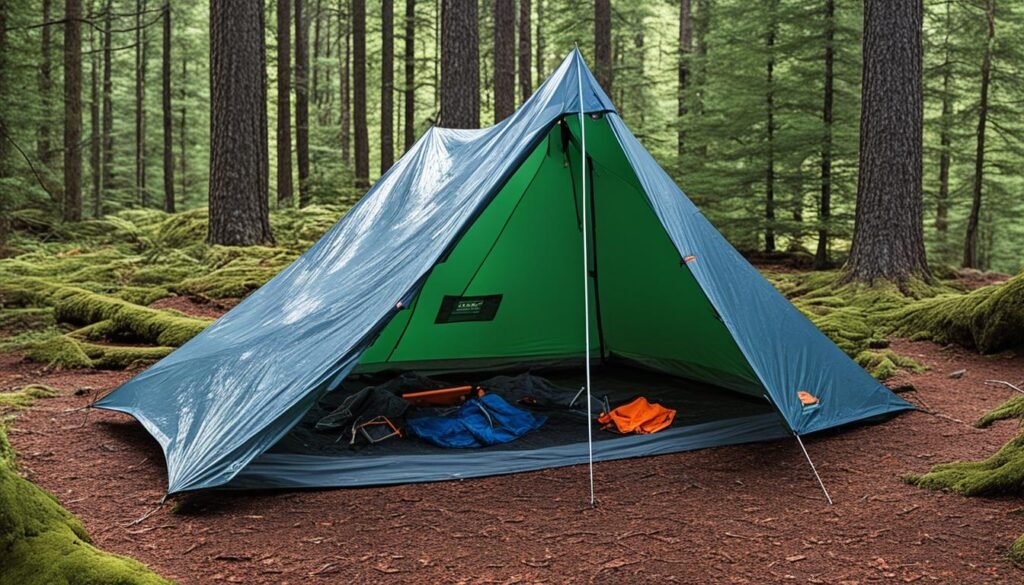Keeping your tent safe from the sun is key to making it last longer. The sun’s UV rays make your tent weaker. In just one month, a tent can lose 5% to 47% tear strength. And after 100 days, most fabrics are over 50% weaker. So, taking care of your tent is super important for it to stay strong.

Taking care of your tent can help a lot. Using products like Nikwax Tent & Gear SolarWash is good. This product not only cleans your tent but also makes it better against the sun. It’s very important not to wash or dry your tent in a machine. Instead, let it dry outside. Use UV-protective sprays on it, especially on the seams.
Checking and caring for your tent often will protect it from UV damage. This means your tent will stay strong and keep you dry on many trips.
Why UV Protection for Your Tent is Important
UV radiation is a big problem for tents because it can harm the fabric. This can make the material weak and more likely to tear. Tents with UPF 15-24 can stop 93.3 to 95.9% of UV rays. Those with UPF 25-39 stop 96.0 to 97.4%. Tents rated 40 or more block 97.5 to 98% or even more. It shows that caring for your camping gear is very important.
Just like a white T-shirt that’s not very protective, some tent fabrics are the same. Fabrics like polyester, nylon, and cotton that’s good against UV are better. Adding coatings like silicone, PE, and PU helps too. But these coatings can wear off and need to be reapplied.
When getting ready for outdoor trips, don’t forget about UVs harming your tent. The sun’s damage can reach not just the tent but also what’s inside and the people there. Good UV protection keeps your gear going for longer. Knowing this helps you choose and care for your tent better, making it work well in any weather.
Understanding the Materials: Nylon vs. Polyester
It’s important to know the materials in tent fabrics. Tents are usually made of nylon or polyester. Each has its own features that affect how the tent works in different situations.

Nylon and polyester both have pros and cons. Nylon is strong and can stretch. But, it gets weaker in the sun. Polyester doesn’t weaken in the sun as much, which many tent makers like.
When fabrics were tested after a month in the sun, their strength dropped. Polyester fabrics with titanium dioxide kept their strength better than other fabrics. This tells us polyester is better at handling the sun for longer.
The thickness of the fabric, measured in denier, matters too. Thicker fabrics often block the sun better. So, they can last longer than thinner ones. After 100 days, thinner fabrics had lost a lot of their strength.
UV rays can damage tent fabrics, making colors fade or whites turn yellow. Polyester stands up to this better than nylon. This means polyester tents look better for longer. They also last longer, which is great for campers.
To learn more about UV damage and how to prevent it, check out this guide on UV and tent fabrics. Polyester fabrics last longer and perform better because they resist UV rays well.
How UV Radiation Affects Tent Fabrics
UV radiation is a big worry for those who love camping. UVA makes up about 95%, with UVB at 5%, of UV radiation we get. This exposure can lead to chemical bonds in tent fabrics breaking down. Common tent materials like nylon and polyester are affected by this.
Over time, the sun’s UV rays can break down tent fabrics.
This happens because the internal bonds in the fabrics start to break. This makes the material much weaker.
The tent can become less strong, less effective, and its life becomes shorter.
You might also see it change color or get a rough, brittle texture.
To protect your camping gear, focus on fabrics with a UPF of 50+. They block over 98% of UV rays. This protection is key in making sure your tents last longer. For example, ABCCanopy canopies offer great UV protection, meeting the UPF 50+ standard.
Knowing about UV radiation and its effects is crucial. Pick tents with high UPF-rated fabrics. Be careful of the sun to keep your outdoor gear in top shape.
Essential Tips for UV Protecting Your Tent
Caring for your tent is key to avoiding UV damage. Fabric can start to breakdown in just two weeks of sun. So, keep your tent safe from quick wear with regular care.
Start with keeping it clean. This stops the spread of plant and bug invaders in new areas. Cleaning also keeps zippers working well. Remember to clean inside and out to remove all dust and dirt.

Protect your tent with products like Nikwax Tent & Gear SolarWash and SolarProof. These products clean and shield your tent from UV rays. Apply them evenly, especially on seams, for the best protection.
Always use UV protectant products as the maker suggests. Rinse them well and let them air dry. Even indoor storage isn’t always safe from the sun’s weakening effects.
Remember, UV and waterproof coatings fade with time. You must reapply them to keep your tent safe and sound. Nikwax is great for the planet and your tent.
Using these tips can make your tent last longer. Enjoy many trips with a well-kept shelter. Care isn’t just about cleaning. It’s also about keeping the sun’s harm away.
Using UV-Protective Sprays and Products
Keeping your tent safe from the sun is key to make it last longer. Using special tent care products stops UV damage. Products like Tent & Gear SolarProof protect from both water and UV rays. This makes your tent last longer.
When you use solarproof treatments, make sure your tent is clean and a bit wet. Pay extra attention to the seams. Here’s how to do it:
- Make sure the tent is clean and slightly wet first.
- Evenly spray the UV-protective product all over.
- Don’t forget the parts that get the most sun, like the roof and sides.
- Let the tent dry in a place with good air flow.
Tent fabrics can weaken a lot due to UV light. In just a month, they might lose 5% to 47% of their strength. Lighter fabrics can get over half as weak in 100 days. But, using a UV protection product cuts this damage a lot. This keeps your outdoor gear strong for a long time.
Using the right tent care products not only protects from UV but also makes your tent last longer. This saves you money for more outdoor fun.
Best Practices for Tent Setup and Storage
Taking care of how you set up and store your tent is crucial. It helps your tent last longer and stay strong against the sun. Choose a camping spot that avoids too much sunlight to keep your tent in good shape.
Always dry your tent well before putting it away. A wet tent can grow mold, making it fall apart. Store it in a place that’s not too hot or cold to keep it safe from harm.
Don’t forget to keep your camping gear in good condition. Use Gear Aid Zipper Cleaner or soapy water to clean your zippers. And, products like Nikwax TX.Direct can help keep your tent fabric waterproof.
When you fold your tent, do it gently to avoid sharp creases. Use products like Gear Aid’s Seam Sure to keep your tent seams waterproof. And make sure to air your tent out every 3 to 4 months to stop mildew.
By following these tips, your tent will last longer and keep you safe on your outdoor adventures.
Common Mistakes to Avoid with Tent UV Care
It’s vital to avoid certain mistakes when looking after your tent. Not checking it often is a big one. Regular inspections prevent unseen damage, like from UV rays. They help fix small issues before they get worse.
- Improper Use of Cleaning Agents: Detergents can harm your tent’s material and its defenses against UV and water. Use a non-detergent soap, cold water, and a soft sponge.
- Machine Washing: Using a machine can damage your tent’s fabric, mesh, and seams. Always hand-wash your tent to keep it in top shape.
- Ignoring Manufacturer’s Instructions: Tents need specific care. Follow the maker’s advice for the best way to preserve your gear.
After your tent faces things like sand, tree sap, or bird droppings, clean it well. This keeps it waterproof and stops it from soaking up water. If it stays damp, mildew can grow. Mildew causes bad smells and harms the tent’s fabric and coatings. Always dry your tent fully before putting it away.
Where you store your tent matters a lot too. A damp or hot spot, like a basement or car trunk, can ruin it. Tent storage should be in a cool, dry place, not tightly packed. This lets the materials breathe. Also, folding or rolling your tent correctly keeps it in good shape.
By avoiding common care mistakes, you’ll keep your tent in better condition. Always check, clean, and store your tent properly. This way, you can keep it safe from UV damage and make it last longer.
How to Handle UV Damage if It Occurs
Even with all precautions, your tent may still get UV damage. Sun’s rays can weaken fabrics like nylon and polyester by breaking down their bonds. SlingFin’s studies show tent fabrics can lose 5% to 47% of their strength in a month of UV exposure. So, it’s vital to know how to manage UV harm well.
When your tent’s fabric starts to get weak or looks like it’s fading, act quickly. Use patch kits to fix any tears. Then, use UV-protective sprays to help the fabric last longer. Always keep a repair kit with you on your trips to handle UV damages right away.
If the fabric loses more than half its strength from too much sun, you’ll need a bigger fix. Consider using newer, tougher fabrics that have titanium dioxide. In serious cases, buying a new tent might be the best move for safety.

